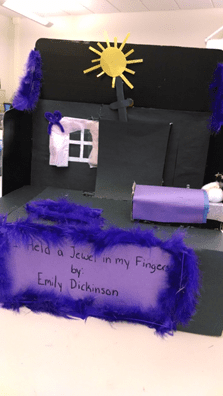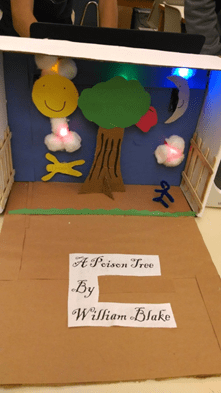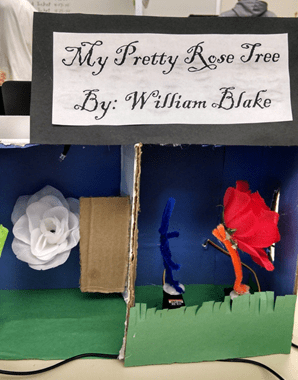Register to receive free access to all teacher materials.
Programming Language
Any language supported by Hummingbird Duo
Subjects
Language Arts
Grades
6-8
Free Teacher Materials
Objective & Learning Goals
1. Students will practice the 21st century skills of collaboration, problem solving, and creativity.
2. Students will demonstrate the reading comprehension skills of drawing conclusions, inference making, and stating artist purpose by analyzing a poem.
3. Students will explore the design process as a collaborative effort by completing a robotic theater programmed with audio file.
Standards
This project was designed to meet a number of standards in English Language Arts. The Common Core ELA standards for Reading: Literature are listed below. This project also incorporates Common Core ELA anchor standards in speaking (CCSS.ELA-LITERACY.CCRA.SL.4-6) and middle school engineering standards (Next Generation Science Standards MS-ETS1-1, MS-ETS1-2, MS-ETS1-3, and MS-ETS1-4).
CCSS.ELA-LITERACY.RL.6.1. Cite textual evidence to support analysis of what the text says explicitly as well as inferences drawn from the text.
CCSS.ELA-LITERACY.RL.6.4. Determine the meaning of words and phrases as they are used in a text, including figurative and connotative meanings; analyze the impact of a specific word choice on meaning and tone
CCSS.ELA-LITERACY.RL.6.5. Analyze how a particular sentence, chapter, scene, or stanza fits into the overall structure of a text and contributes to the development of the theme, setting, or plot.
CCSS.ELA-LITERACY.RL.6.6. Explain how an author develops the point of view of the narrator or speaker in a text.
CCSS.ELA-LITERACY.RL.7.3. Analyze how particular elements of a story or drama interact (e.g., how setting shapes the characters or plot).
CCSS.ELA-LITERACY.RL.7.4. Determine the meaning of words and phrases as they are used in a text, including figurative and connotative meanings; analyze the impact of rhymes and other repetitions of sounds (e.g., alliteration) on a specific verse or stanza of a poem or section of a story or drama.
CCSS.ELA-LITERACY.RL.7.5. Analyze how a drama’s or poem’s form or structure (e.g., soliloquy, sonnet) contributes to its meaning.
CCSS.ELA-LITERACY.RL.8.1
Cite the textual evidence that most strongly supports an analysis of what the text says explicitly as well as inferences drawn from the text.
CCSS.ELA-LITERACY.RL.8.2. Determine a theme or central idea of a text and analyze its development over the course of the text, including its relationship to the characters, setting, and plot; provide an objective summary of the text.
Photo Gallery
Lesson Procedures:
Class session #1
- Explain to students that they will be placed in a group of 3 or 4 students to make a robotic diorama complete with audio of an assigned poem.
You can use the following videos to demonstrate the concept.
http://youtu.be/wRDbW-RRvOo (A Noiseless Patient Spider by Walt Whitman)
http://youtu.be/wScfmduS2cM (Bright Star by John Keats) - Using the user manual connecting electronics pages and a hummingbird with one of each component connected, quickly show the parts working.
- By the end of the class period, the students should know their group members and the poem that they are assigned.
Class session #2
- Give students the Poetry Analysis Planning Document. You can either give them enough to complete their entire poem or have a set number of lines required for analysis/planning for each group. Explain that they need to do the following four steps:
- Write the lines of the poem (can be a single line or a small group of lines)
- Explain what these lines mean literally and figuratively
- Brainstorm symbolism
- Brainstorm a way that robotic components could be used for the symbolism
Example of this—- “Some say the world will end in fire,
Some say in ice.” - This reminds us of the age old question of whether it would be worst to die by burning or to die by freezing.
- To represent the fire – a picture of flames with things colored red, orange, yellow
- To represent the ice – plastic icicles from Christmas decorations, foil balls to represent snow, shredded white paper and things that are white or blue
- To use robotics to represent the fire—red LEDs, a picture of flames moving on a motor or a servo
- To use robotics to represent ice—blue LEDs, an open cup attached to a servo in which white shredded paper drops from
- “Some say the world will end in fire,
Class session #3
- Use the BirdBrain programming resources to help students explore the Hummingbird parts and how to write programs to control them.
- Begin checking the Poetry Analysis Planning Documents for each group. Per teacher opinion, groups who have made adequate progress in their planning may start building today. The amount of time spent using the Poetry Analysis Planning Document will depend on the following factors: length of the poem, difficulty level of the poem, student reading ability, and the group’s level of collaborative communication.
Class session #4
This class period should be devoted entirely to building. To help students manage their time encourage students to create their artwork at home for homework points.
Class session #5
- Give each student a copy of the Audacity Instructions handout. The handout included in this lesson gives instructions for completing this step of the project on our district’s laptops. It can serve as an example for you.
- Watch the following screen casts on how to create the audio for the poem and how to make it into an expression. This will take approximately 5 minutes
http://youtu.be/N36Krgw_6Jo (Making audio files of your poem using Audacity)
http://youtu.be/v58h-qzN7Ak (Importing your WAV file into the Visual Programmer software) - The remainder of the session will be for building and creating audio files.
Class session #6 and #7
Whether you need one or two more days will depend on the poems assigned (length/difficulty level) and the overall abilities of the students as well as the teacher’s familiarity with all aspects of the project.
Note: For the last two school years, we have invited groups of students who have been identified as either gifted or high achieving into our school for a quick build session. The students are able to complete this work in three hours with shorter poems.
Class session #8
- This is “the show” day and we ask each group to make a short introduction before running their program for the class. The key points for the introduction are—
- Your name, the title of the poem and the author
- Point out an electronic component and state why you are including it and what it represents
- Each group member should do one electronic component
- Each group member should tell about something they learned through the project
- We video the “show” and students are given digital copies of their presentation as a keepsake.
- Robots will need to be taken apart on this day. All robotic components need to be placed back in the kit.
- Reflection on the experience paragraphs are assigned for homework.
Possible Poems:
- Fire and Ice by Robert Frost
- Nothing Gold Can Stay by Robert Frost
- The Pasture by Robert Frost
- Daddy Fell into the Pond by Alfred Noyes
- My Pretty Rose Tree by William Blake
- A Poison Tree by William Blake
- I held a jewel by Emily Dickinson
- “Hope” is the thing with feathers by Emily Dickinson
- A Noiseless Patient Spider by Walt Whitman
- The Bean Eaters by Gwendolyn Brooks
- Theme in Yellow by Carl Sandburg
- Grass by Carl Sandburg
- The Sun Has Long Been Set by William Wordsworth
- Bright Star by John Keats
- The Human Seasons by John Keats
- Eldorado by Edgar Allan Poe
- A Boat Beneath a Sunny Sky by Lewis Carroll
- The Crocodile by Lewis Carroll
- As I Grew Older by Langston Hughes
- Dreams by Langston Hughes
- I Know Why the Caged Bird Sings by Maya Angelou
- The Watcher by Rudyard Kipling
- Calm At Sea by Johann Wolfgang Goethe



